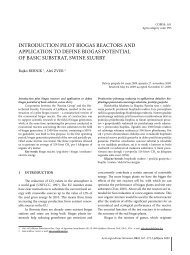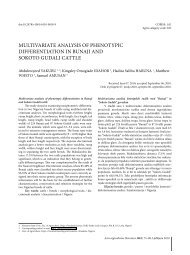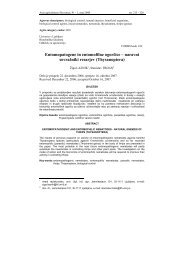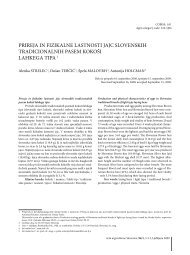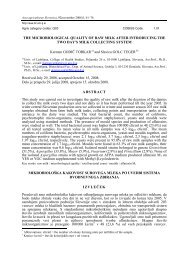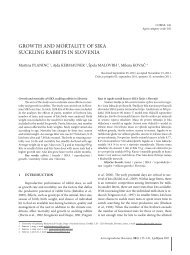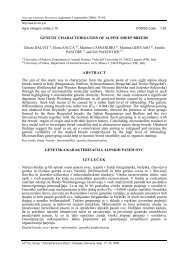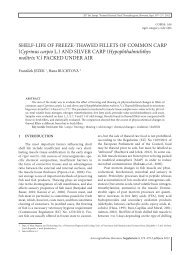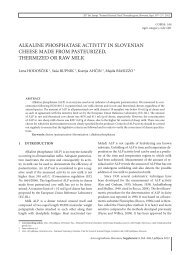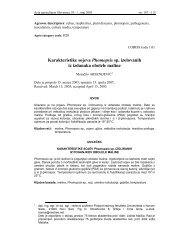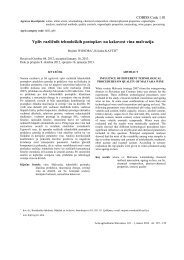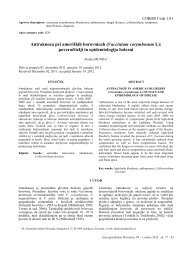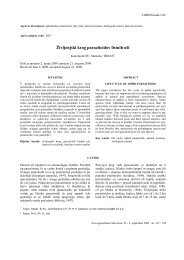PDF - Acta agriculturae Slovenica
PDF - Acta agriculturae Slovenica
PDF - Acta agriculturae Slovenica
Create successful ePaper yourself
Turn your PDF publications into a flip-book with our unique Google optimized e-Paper software.
<strong>Acta</strong> <strong>agriculturae</strong> slovenica, suplement 1(avgust 2004), 87–91.<br />
http://www.bfro.uni-lj.si/zoo/publikacije/zbornik/suplementi/index.htm<br />
12 th Int. Symp. “Animal Science Days”, Bled, Slovenia, Sept. 2–4, 2004.<br />
Original scientific article<br />
Izvirni znanstveni prispevek<br />
INDICATORS OF BIOLOGICAL VALUE OF THE PHEASANT MEAT ORIGINATED<br />
FROM NATURAL AND CONTROLLED BREEDING<br />
Zvonimir TUCAK a) , Mario ŠKRIVANKO b) , Marko KRZNARIĆ c) , Štefica POSAVČEVIĆ d)<br />
and Ivica BOŠKOVIĆ e)<br />
a)<br />
Josip Juraj Strossmayer Univ. of Osijek, Fac. of Agriculture, Trg Sv. Trojstva 3, HR-31000 Osijek, Croatia, Prof.<br />
b)<br />
Croatian Veterinary Institute Zagreb, Veterinary Dept. in Vinkovci, J. Kozarca 24, HR-32000 Vinkovci, Croatia,<br />
M.Sc.<br />
c) b)<br />
Same address as , Ph.D.<br />
d) b)<br />
Same address as<br />
e) a)<br />
Same address as<br />
ABSTRACT<br />
The authors made a comparative research of the influence of natural food and mixture prepared<br />
according to prescription on the metabolism of pheasants, which is evident as biological value of<br />
meat. The results indicated that pheasants fed on natural food had much higher biological value<br />
of meat compared to those which consumed commercially prepared mixture. The<br />
recommendation of the study is that people as the ultimate consumers take an opportunity to<br />
choose meat of the pheasants, or other winged game originated from natural way of life.<br />
Key words: pheasants / breeding / animal nutrition / meat / biological value<br />
KAZALCI BIOLOŠKE VREDNOSTI MESA FAZANOV IZ NARAVNIH IN<br />
KONTROLIRANIH REJ<br />
IZVLEČEK<br />
Avtorji so primerjali vpliv krme na metabolizem pri fazanih, izražen kot biološka vrednost mesa.<br />
Primerjali so živali, ki se prehranjujejo prosto živeče v naravi, s tistimi, ki so jih krmili s krmno<br />
mešanico. Rezultati kažejo na boljšo biološko vrednost mesa pri fazanih, ki so se prehranjevali s<br />
krmo iz naravnega okolja v primerjavi s fazani krmljenimi s komercialno krmno mešanico.<br />
Avtorji potrošnikom priporočajo izbiro mesa fazanov in druge divje perutnine iz naravnega<br />
okolja.<br />
Ključne besede: fazani / reja / prehrana živali / meso / biološka vrednost<br />
INTRODUCTION<br />
The point of our researches was to establish biological value of pheasant meet (Phazianus<br />
colchicus) bred in nature and in pheasants farm. Pheasants which are used in our research were<br />
shut down during the November and December 2002.<br />
MATERIALS AND METHODS<br />
The pheasant (Kiessling, 1977; Treer end Tucak, 1991; Tucak end et al., 2002) in our<br />
researches are from Osijek - Baranya county in The Republic of Croatia, in which are placed<br />
numbers of hunting-grounds and pheasants farm «Darda».<br />
Analized meet samples were from two experiment groups:
88<br />
<strong>Acta</strong> <strong>agriculturae</strong> slovenica, suplement 1(avgust 2004).<br />
– pheasant bred in nature: 20 pieces (10 males and 10 females)<br />
– pheasant bred in pheasants farm «Darda»: 20 pieces (10 males and 10 females).<br />
After pheasant had been killed, we determined the total weight of each pheasant.<br />
– total weight of each pheasant with feathers<br />
– total weight of each pheasant with out feathers.<br />
Preparing the body for analyzing:<br />
– 1) remove the head and tights with drumsticks<br />
– 2) body choped in parts: brests, tights with drumsticks, backs, wings, heart and liver.<br />
Samples had been taken separately, from brest muscle (white meat) and muscle from tights<br />
with drumsticks (dark meat). Muscles were separated from bones, and from muscles skin with<br />
subcutaneous fat were removed. Prepared samples of «white and dark» meat were cut up in<br />
small pieces and homogenized for purpose of analysis.<br />
Every sample had been chemicaly analyzed (Christie end Moore, 1972; Grahn et al., 1993;<br />
Grahn et al., 1993) to establish ratio (%) of moisture, proteins (Kjeldahl), fat (Soxhlet), calcium,<br />
phosphorus, ash and energetic value. Results were processed by STATISTICA program version<br />
6.0.<br />
For establishing the difference between experimental groups were used ANOVA.<br />
RESULTS AND DISCUSSION<br />
In Table 1. had been shown weight (g) and base parts of pheasant body in absolute (g) and<br />
relative (%) values. The higest weight achieved males of wild pheasant (1232.4 ±147.36 g). The<br />
differences between pheasant testing groups were statistically very significant (P
Tucak, Z. et al. Indicators of biological value of the pheasant meat … from natural and controlled breeding. 89<br />
The diferences betwen groups relating to leg weights were statisticaly very significant<br />
(P
90<br />
<strong>Acta</strong> <strong>agriculturae</strong> slovenica, suplement 1(avgust 2004).<br />
Table 4. Probably chemical composition of brest<br />
Cultivation pheasant Wilde pheasant<br />
m*(n=10) f** (n=10) m* (n=10) f**(n=10)<br />
Moisture, % 72.61±0.69 71.77±1.22 72.33±10.6 72.43±0.62 0.221<br />
Fatt, % 1.15±0.33 1.69±1.21 0.96±0.25 1.14±0.39 0.100<br />
Proteines, % 25.11±0.62 25.38±0.68 25.57±1.07 25.32±0.47 0.586<br />
Ash, % 1.16±0.03 1.15±0.04 1.14±0.04 1.12±0.06 0.105<br />
Ca, % 0.019±0.003 0.018±0.003 0.032±0.006 0.029±0.006
Tucak, Z. et al. Indicators of biological value of the pheasant meat … from natural and controlled breeding. 91<br />
REFERENCES<br />
Christie, W.W./ Moore, J.H. The lipid composition and triglyceride structure of eggs from several avian species.<br />
Comparative Biochemistry and Physiology, Part B: Biochemistry and Molecular Biology, 41(1972)2, 297–306.<br />
Grahn, M./ Göransson, G./ Von Schantz, T. Spacing behaviour of male pheasants, Phasianus colchicus, in relation to<br />
dominance and mate acquisition. Animal behaviour, 45(1993)1, 93–103.<br />
Grahn, M./ Göransson, G./ Von Schantz, T. Territory acquisition and mating success in pheasants, Phasianus<br />
colchicus: an experiment. Animal Behaviour, 46(1993)4, 721–730.<br />
Kiessling, K.H. Muscle structure and function in the goose, quail, pheasant, guinea hen, and chicken. Comparative<br />
Biochemistry and Physiology, Part B: Biochemistry and Molecular biology, 57(1977)4, 287–292.<br />
Treer, T./ Tucak, Z. Agrarna zoologija. Zagreb, Školska knjiga, 1991, 1–182.<br />
Tucak, Z./ Florijančić, T./ Grubešić, M./ Topić, J./ Brna, J./ Dragičević, P./ Tušek, T./ Vukušić, K. Lovstvo. Osijek,<br />
Poljoprivredni fakultet u Osijeku, Sveučilište J. J. Strossmayera, 2002, 1–386.<br />
Tucak, Z./ Klaić, T. Einfluss der verfutterung von federmehl auf die entwicklung und das federwachstum bei jungen<br />
fasanen. Zeitschrift für Jagdwissenschaft, 43(1997)1, 65–69.



